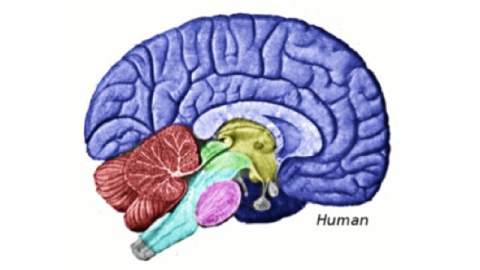Study: Facebook Users’ Brains Are Denser Than Others’

This paper, published online yesterday in the Proceedings of the Royal Society B, introduces a new term to neuroscience: The FBN, or “Facebook number.” Your Facebook number is, of course, your total of friends on the social network. According to Ryota Kanai and co-authors, the higher your Facebook number, the greater the density of certain regions of your brain.
The researchers performed MRI scans on 125 students at University College, London, measuring the density of grey matter in the volunteers’ brains. (Grey matter consists of neurons, the branch-like dendrites through which they communicate with each other, supporting glial cells and other crucial brain infrastructure. Grey matter is where the brain’s main work of processing signals is done.) As they’d asked for each student’s FBN, the researchers could hunt for areas where gray matter density seemed to correlate. They found three strong links: the left middle temporal gyrus (which has been linked in other studies to face-recognition), the right posterior superior temporal sulcus (linked to perceptions of other’s gazes, mouths and hands, as well as their intentions) and the entorhinal cortex, which is implicated in memory. (They also found a link between the FBN and the size of the amygdala, a region crucial to fear, sexual arousal, surprise and other alarming experiences—but the correlation wasn’t as strong or as consistent.)
Some neuroscientists criticize whole-brain scans that look for “regions of interest” as statistically unsound fishing expeditions. As part of their effort to make sure they’d found a real connection, then, Kanai et al. duplicated the experiment with 40 other students, and found the same correlation.
What’s especially interesting about the result is that the increased size of the three brain regions correlated only with the size of Facebook networks. In a later experiment, the researchers related grey-matter density to both volunteers’ FBN’s and the size of their flesh-and-blood networks (as measured by their answers to questions like how many people came to your 18th or 21st birthday party? and how many people can you name who would do you a favor if you asked?) The size of people’s physical social networks wasn’t significantly tied to the size of the three Facebook-relevant regions in their brains. (On the other hand, where the researchers found a link between network size and amygdala density, it applied to both Facebook and real-world networks.)
A correlation, the authors note, says nothing about causation: Maybe Facebook use swells the size of brain regions devoted to tracking and maintaining relationships. Or maybe people who already have such robust regions are naturally more inclined to thrive on Facebook. Moreover, they point out, they haven’t established what it is that those regions actually do during a Facebook session, so they can only speculate about what’s happening whenever brain and Facebook meet. And they’re also careful to issue what I call a “Henrich caveat“: They used university students because, they claim, those people are heavy Facebook users (so, um, it really had nothing to do with the fact that they happened to be on-campus?). Results with less weird people could be different.
All that said, it certainly is interesting, though, that the striking differences they found weren’t common to both Facebook and three-dimensional networks. Their results suggest that even at the level of brain anatomy, Facebook friendship isn’t the same as the physical kind.
Kanai, R., Bahrami, B., Roylance, R., & Rees, G. (2011). Online social network size is reflected in human brain structure Proceedings of the Royal Society B: Biological Sciences DOI: 10.1098/rspb.2011.1959





